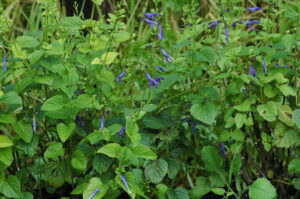S & J Nursery’s Guide to Growing
Perennial Salvia
Black and Blue
Anise Scented Sage for the Northeast Florida Landscape
( Salvia guaranitica ‘ Black and Blue ‘ )
 Perennial Salvia Black and Blue Origins:
Perennial Salvia Black and Blue Origins:
Salvia Guaranitica is native to South America.
– A shrubby or semi woody perennial plant, grown as an annual in colder climate zones. Here in the North Florida | Jacksonville | St. Augustine area gardens and landscapes, Salvia guaranitica Black and Blue is a reliable
if sometimes herbaceous ( depending on the planting location) Perennial that will last many seasons in the garden.
– This compact low maintenance plant is perfect for Florida’s hot summers and keeps on blooming when other flowering plants have begun to decline. Simply pinch back spent flowers during the heat of the summer and watch it bloom all over again in a matter of weeks!
Perennial Salvia Black and Blue Preferred Exposure:
– Perennial Salvia Black and Blue will do best with a partial sun / partial
shade exposure in the North Florida | Jacksonville | St. Augustine area landscape.
Perennial Salvia Black and Blue Foliage:
– Large, minty green heart shaped foliage, evergreen to herbaceous depending on the winter season and planting location.
– Foliage has a strong Anise scent especially when crushed.
Perennial Salvia Black and Blue Soil Preference / Salt tolerance:
– Salvia Guaranitica is not particular about the components of the soil it is
planted in providing they are planted in a well draining location.
– Unknown Salt tolerance. Have it at the beach? Let us know how it did!
Perennial Salvia Black and Blue Size Variance:
– Salvia Guaranitica will grow quickly grow to heights of 3-4
feet and 3 feet wide. Ideal for larger back of the border plantings and perfect in mixed flowering containers.
Perennial Salvia Black and Blue Growth Habit:
– Semi evergreen to herbaceous perennial plant forms an attractive upright mound of foliage, slightly taller than it is wide.
Perennial Salvia Black and Blue Growth Rate:
– Fast growing salvia guaranitica can be expected to reach its full height in
just its first growing season after being planted in the North Florida | Jacksonville | St. Augustine area landscape.
Perennial Salvia Black and Blue Bloom:
– Beautiful bright, vibrant, well just a hard to describe vivid blue colored flower with dark blackish purple calyx’s. ( Web image is showing more of a purple look but the flowers really are a bright vibrant bluish color, I Promise! Ok, maybe it has a little purple in it too…where is that Crayola box when you need it? Well, no matter what you call it, when you plant it you’ll love it guaranteed! )
– Flower stalks rise above the foliage in early summer and continue
blooming to the first frost.
– Remove spent blooms and cut foliage back after flowering begins to decline and the plant will regrow and rebloom within weeks!
– Plant reseeds itself into the garden if blooms are allowed to mature and
form seed heads.
Perennial Salvia Black and Blue Water Requirements:
– Salvia Guaranitica will perform best when supplemental irrigation is supplied.
– Regular water is necessary to get the plant rooted and growing on its own after being planted in the ground from a nursery container.
Butterfly or Bird Attracting:
– S & J Nursery’s Perennial Salvia Black and Blue will attract butterflies and
hummingbirds to your North Florida gardens landscape.
Best Uses For Salvia Black and Blue in the North Florida | Jacksonville |St. Augustine area garden:
– Easy maintenance blooming plant for perennial beds and flower borders.
– Great selection for a mixed container planting.
– Plant in masses for a blooms display that cant be missed!
– Salvia Black and Blue makes a great companion plant for other perennials in
the garden.
– Deer resistant flowering selection!
– Attracts butterflies!
Care of Perennial Salvia Black and Blue in the North Florida | Jacksonville | St.
Augustine area landscape:
– Water every day during the establishment period after planting in the garden from a nursery container, once plants have established themselves into the landscape, you can begin to taper watering back to just a semi weekly application if local rainfall levels are low.
– Leave foliage and roots in place for next years growth.
– Trim back both foliage and blooms in spring regardless of whether your planting has kept its leaves or died back. Trim back the woody stems that have formed to just 6-12 inches above ground level or all the way back to ground level if needed to allow the plant to regrow new lush foliage for the new season.
– Fertilize each spring, and again when trimming in late summer with a handful of garden compost or a mixture of Milorganite and a slow release poly coated plant food such as Osmocote or Stay Green general purpose plant food or 10-10-10.

